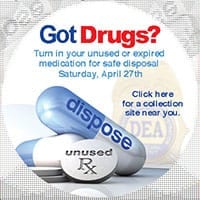The U.S. Drug Enforcement Administration, in coordination with more than 4,000 state, local, and tribal law enforcement agencies across the country, will hold its sixth annual drug “take-back” day April 27 from 10 a.m. to 2 p.m. Click here to find a DEA collection site near you. Anyone in possession of unwanted or unneeded prescription medications should gather them together and take them to the nearest collection site, where qualified personnel will be on hand to take possession and dispose of these excess drugs safely and securely. During the five previous Prescription Drug Take-Back Days, the DEA collected more than 2 million pounds of old medications. Given the fact that the average American brings home 10 new prescriptions for pharmaceutical drugs every year, it is hardly surprising that there are so many expired pills and medicinal liquids floating around out there.
Taking Responsibility
It was the Substance Abuse and Mental Health Services Administration’s 2011 National Survey on Drug Use and Health that revealed the shocking truth about America’s prescription drug problem. The 6 million people who are addicted to legally prescribed medications outnumber those who are addicted to cocaine, heroin and hallucinogens combined, and, according to the survey, as many as 70 percent of these substance abusers are obtaining a significant portion of their drugs from family, friends, neighbors and acquaintances. In some instances, the drugs are being given away, but in most cases, addicts are pilfering them from the bathrooms, bedrooms and drawers of unsuspecting loved ones, or getting them from others who have done the same. This latter practice is particularly common among teenagers, and in many locales, thriving black markets have been set up to supply addicted adolescents with medications stolen from hundreds of home medicine cabinets. By turning in their excess prescription pills and liquids at a nearby collection center on the upcoming Take-Back Day, concerned citizens can take a proactive role in nipping this problem in the bud, helping to remove temptation from those who are so desperate to get their daily fix that they would steal from and violate the trust of those closest to them. This DEA initiative can also help remove temptation from those struggling to overcome their own prescription drug habits by providing them with an excellent opportunity to dispose of their secret drug stashes. And if there are young children in the home, that should provide another strong motivation for some to participate in the program, since thousands of kids are rushed to emergency rooms in the U.S. each year to be treated for poisoning after consuming potentially lethal substances—including prescription drugs—that they discovered in their own homes. It is important for those looking to get rid of excess prescription drugs to dispose of them safely, which doesn’t mean throwing them in the garbage, washing them down the sink, or flushing them down the toilet. The U.S. Geological Survey has revealed that 80 percent of the streams and 25 percent of groundwater supplies in the United States have been contaminated by prescription medications, and scientific testing has found traces of over 150 prescription substances in the water, soil and animals as far away as the Arctic Circle. When released into the environment, these drugs have the potential to seriously disrupt the reproductive cycles of wildlife, fuel the development of antibiotic-resistant strains of disease-causing microbes, and cause health problems in human beings who could easily absorb them by consuming contaminated food or water.
Raising the Consciousness of a Nation
The National Prescription Drug Take-Back Day has obvious practical value. We should not overlook its more intangible benefits, however; the publicity this initiative is receiving is helping to raise people’s awareness about the problem of prescription drug abuse and about how easy it is for addicts to get the drugs they desire without having to visit a doctor. Additionally, the existence of this program is helping to get the message across about how important it is to dispose of prescription drugs with diligence and care because of the significant damage they can cause to the environment, to wildlife, and to human health.

